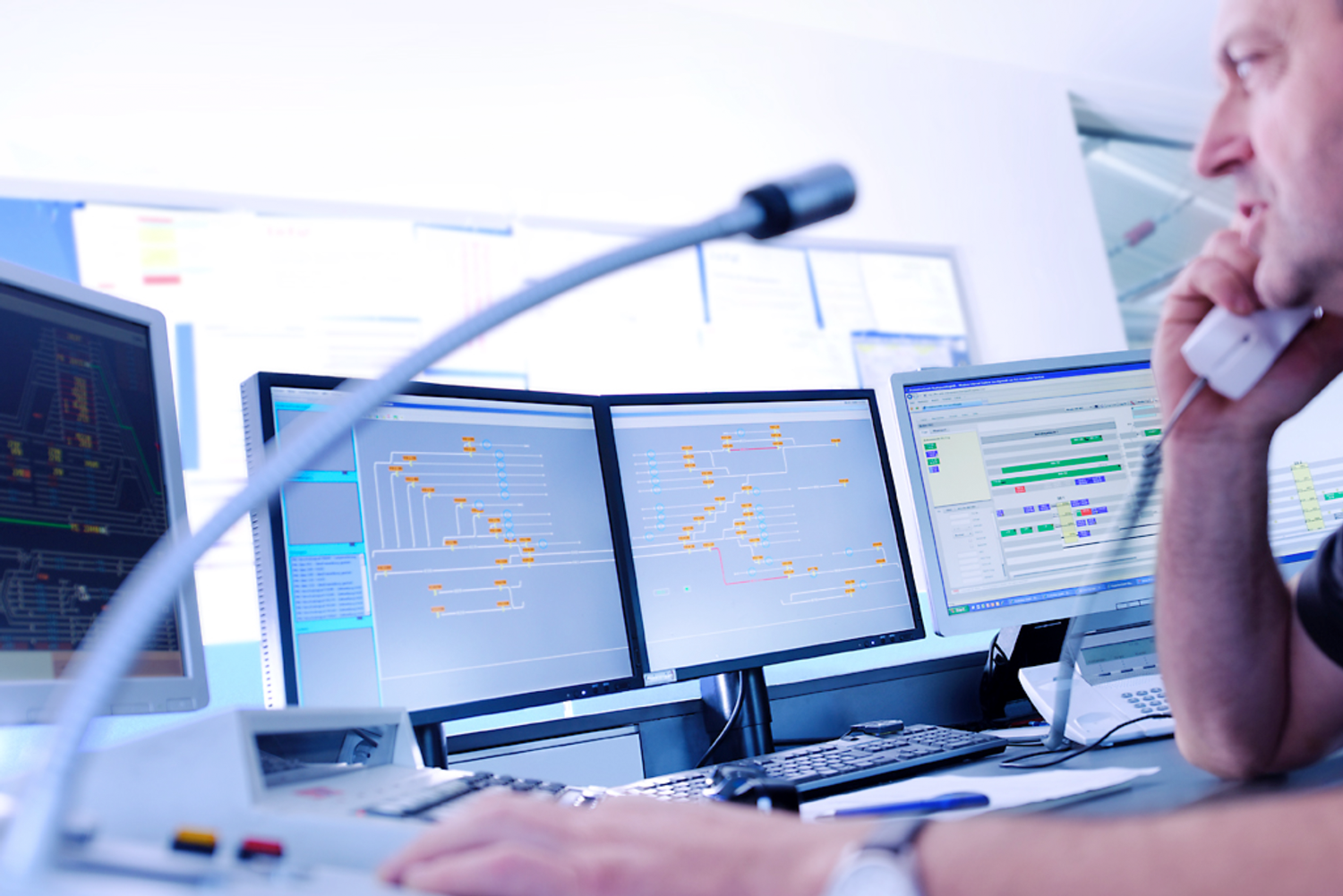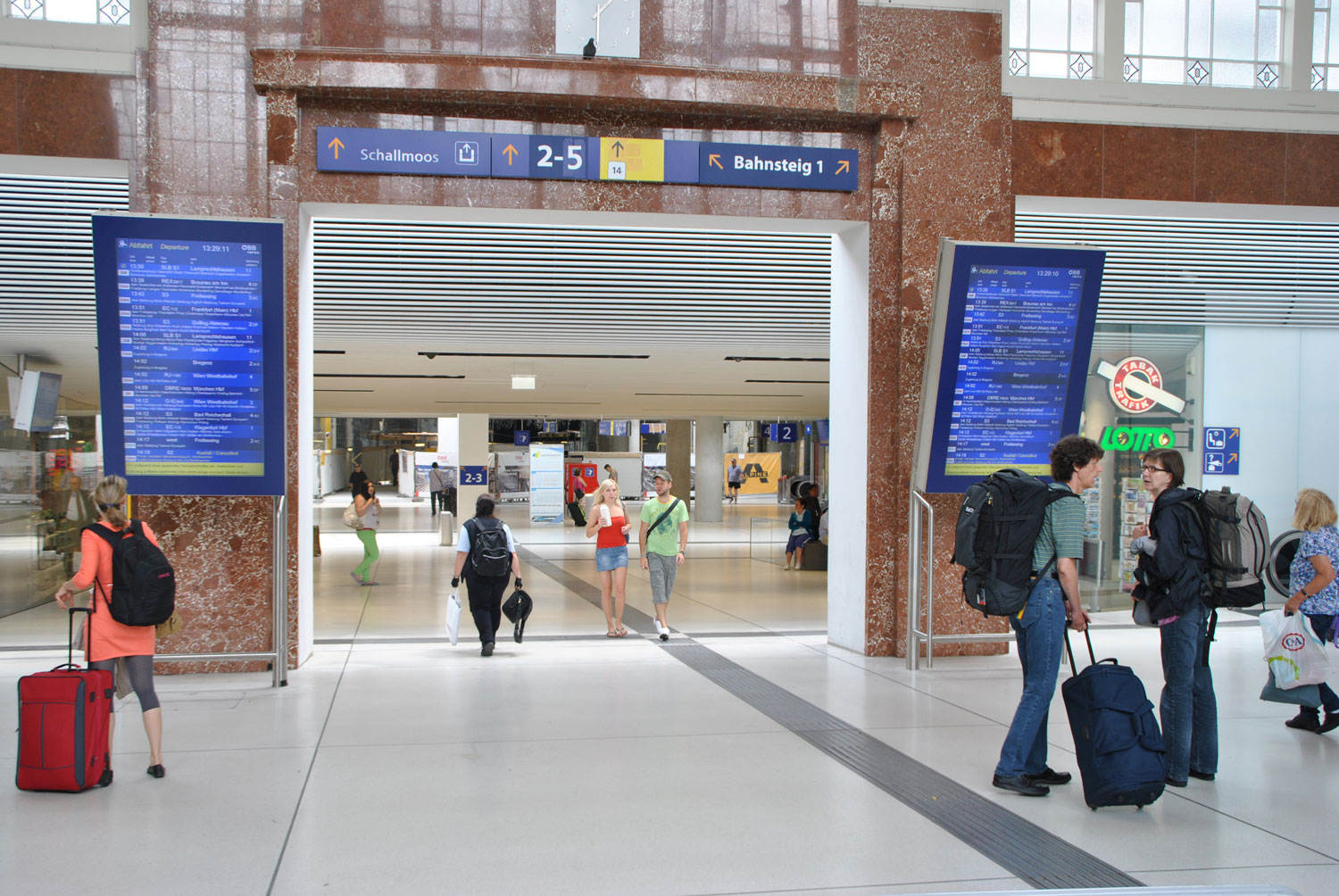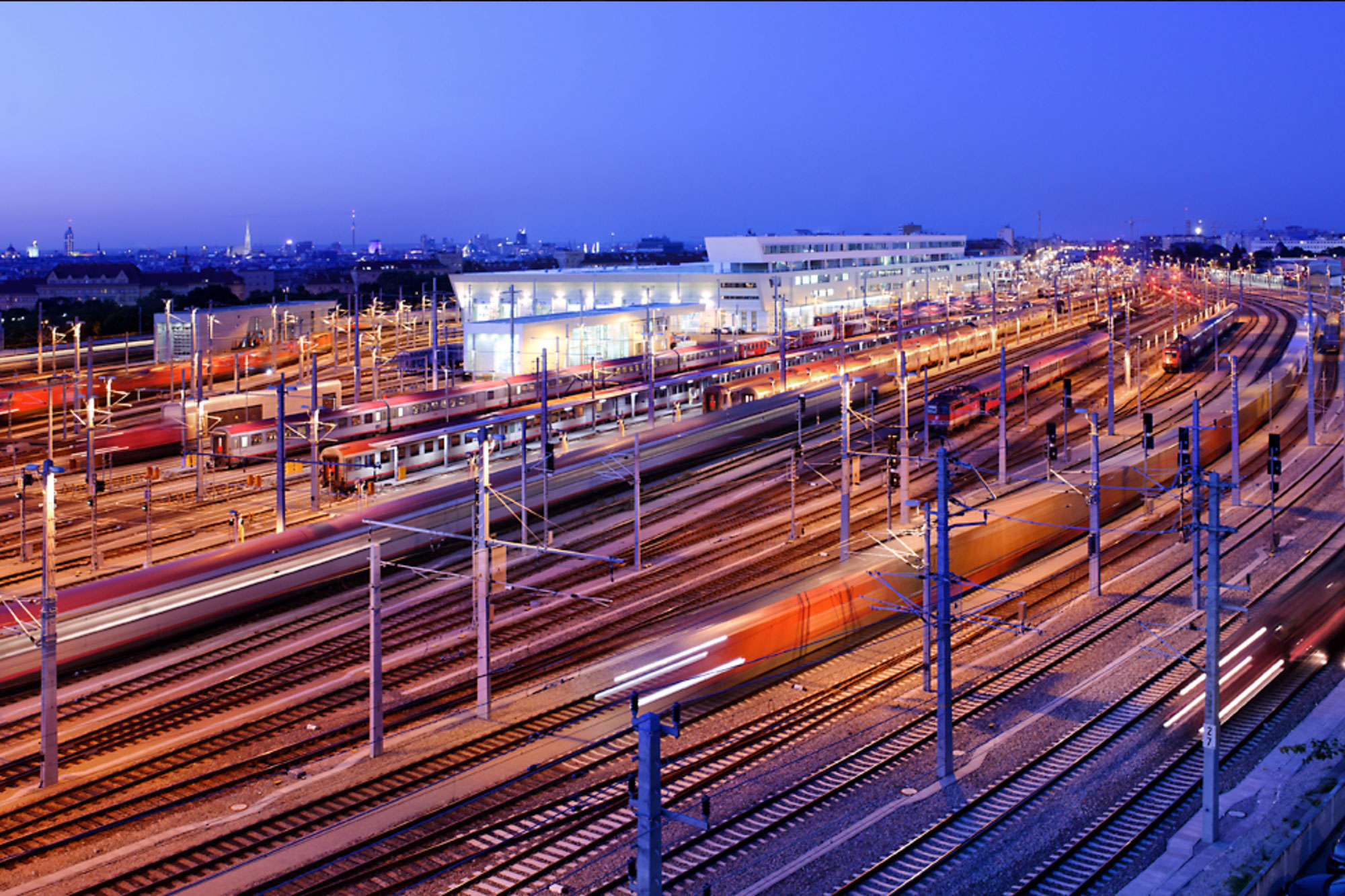Funkwerk Mobility Platform: Our References
ÖBB – Austria
Proven in practice: On this page you will find use cases and references relating to the use of the Funkwerk Mobilty Platform.
The Austrian Federal Railways (ÖBB) are the largest state-owned railroad company in Austria. Over 2.4 million train journeys are handled each year on a good 10,000 track kilometers (as of 2018).
Increasing international passenger traffic, the consolidation of personnel in operations management centers (OMCs) and the optimization of train path capacities have necessitated a change in operations management strategy in recent years. The renewed concept provides for a centralized and highly automated execution of business processes. Due to these requirements, ÖBB introduced the AURIS passenger information system from Funkwerk across the board.
The main focus is on a high degree of automation of complex business transactions in order to provide passengers with the necessary information efficiently, especially in the event of deviations in the operating sequence. This requires a close link between the passenger information system and ÖBB’s existing train dispatching system, ARAMIS: All timetable data as well as train messages are transferred from this system to AURIS.
In 2008, ÖBB started with the installation and commissioning of AURIS on a pilot route from Kufstein via Innsbruck to the Brenner Pass with 33 stations controlled from the then new BFZ in Innsbruck. Since this positive success, 800 of the 1100 stations are currently controlled fully automatically from the BFZs in Innsbruck, Salzburg, Vienna, Villach and Linz.

Since its commissioning, the system has been continually modernized and enhanced with additional functionalities, and thus optimized for ÖBB’s operational processes.
CLOSE CONNECTION TO THE TRAIN DISPATCHING SYSTEM
Scheduled as well as dispatching timetables are automatically taken over by the ARAMIS system.
Operational deviations such as train swapping, train splitting, through-connection, rail replacement traffic are automatically derived by means of a comparison, and deviations in the operational sequence are detected and extracted such as track changes and delays.
Current train movements for controlling entry and passage announcements are tapped from decentralized interlocking computers.
TEXT-TO-SPEECH AND VOICE OUTPUT
The text-to-speech technology used by ÖBB is used for automatic announcements, because only speech synthesis guarantees the greatest possible flexibility in voice output.
High ongoing maintenance costs, which are incurred by recurring recording of speech modules, are thus prevented.
Since 2015, the Cura® product series from Funkwerk has been used as the public address system at most of the stations.
Authorized ÖBB employees can also use LTE- or GMS-R-based cell phones to make live announcements at the stations.

Visual passenger information
Since 2012, ÖBB has been using LCD displays from Funkwerk, which have energy-efficient LED backlighting in addition to higher resolution and strong color contrast. One year later, the supply of 47-inch TFT monitors in HD quality began, which are used as departure and arrival monitors with a wide variety of layouts.
Since 2020, Funkwerk has been supplying ÖBB with monitor and display cases in pedestal and standing variants. For people with limited mobility, the information is also presented barrier-free.
Paper notices about carriage status are largely a thing of the past at ÖBB. Electronic car status displays present current train compositions on a daily basis at the respective platform or in the concourse.
At the end of 2019, info steles with a read-out function were installed at eleven pilot locations with low train density. At the push of a button, passengers receive acoustic updates on train traffic and the current operating situation.
Information on all channels
In 2020, a start was made on providing passengers with current information from the operations center on their cell phones as soon as they enter one of ÖBB’s operating stations and connect to the WLAN there.
Thinking into the future: current developments
Thanks to the Greenlight project implemented internally at ÖBB, it will be possible in the future to generate corresponding entry and passage messages on lines without train control.
The position of the trains will be determined by GPS. The current position is transmitted from the traction units to a control center. Downstream systems send corresponding information when approaching the operating points, which is used by AURIS to inform passengers about arriving trains.
Starting in spring 2022, train destination indicators will use LED technology. This technology is not only superior to LCD technology in ecological terms, but is also characterized by the possibility of using colors, for example, when displaying operator or line symbols.
Before the timetable change in 2021/22, the connection to the Railway Emergency Management System (REM) was realized. As a result, fault messages can be processed more efficiently and better coordinated. In addition, a comprehensive logging system allows possible passenger complaints to be tracked more quickly.
Components of the
Mobility Platform
Passenger information
Passenger information systems enable the fully automatic control of all processes in the operational sequence.
Displays
Indicators, displays, columns and monitors provide passengers with visual information in real time.
Public address
Public address systems ensure that important information and announcements are also given out acoustically.
Text-to-Speech
Text-to-speech is the digital generation of speech from text. Announcements can be synthesised live.
Funkwerk Mobility Platform: Our References
ÖBB – Austria
Proven in practice: On this page you will find use cases and references relating to the use of the Funkwerk Mobilty Platform.
The Austrian Federal Railways (ÖBB) are the largest state-owned railroad company in Austria. Over 2.4 million train journeys are handled each year on a good 10,000 track kilometers (as of 2018).
Increasing international passenger traffic, the consolidation of personnel in operations management centers (OMCs) and the optimization of train path capacities have necessitated a change in operations management strategy in recent years. The renewed concept provides for a centralized and highly automated execution of business processes. Due to these requirements, ÖBB introduced the AURIS passenger information system from Funkwerk across the board.
The main focus is on a high degree of automation of complex business transactions in order to provide passengers with the necessary information efficiently, especially in the event of deviations in the operating sequence. This requires a close link between the passenger information system and ÖBB’s existing train dispatching system, ARAMIS: All timetable data as well as train messages are transferred from this system to AURIS.
In 2008, ÖBB started with the installation and commissioning of AURIS on a pilot route from Kufstein via Innsbruck to the Brenner Pass with 33 stations controlled from the then new BFZ in Innsbruck. Since this positive success, 800 of the 1100 stations are currently controlled fully automatically from the BFZs in Innsbruck, Salzburg, Vienna, Villach and Linz.

Since its commissioning, the system has been continually modernized and enhanced with additional functionalities, and thus optimized for ÖBB’s operational processes.
CLOSE CONNECTION TO THE TRAIN DISPATCHING SYSTEM
Scheduled as well as dispatching timetables are automatically taken over by the ARAMIS system.
Operational deviations such as train swapping, train splitting, through-connection, rail replacement traffic are automatically derived by means of a comparison, and deviations in the operational sequence are detected and extracted such as track changes and delays.
Current train movements for controlling entry and passage announcements are tapped from decentralized interlocking computers.
TEXT-TO-SPEECH AND VOICE OUTPUT
The text-to-speech technology used by ÖBB is used for automatic announcements, because only speech synthesis guarantees the greatest possible flexibility in voice output.
High ongoing maintenance costs, which are incurred by recurring recording of speech modules, are thus prevented.
Since 2015, the Cura® product series from Funkwerk has been used as the public address system at most of the stations.
Authorized ÖBB employees can also use LTE- or GMS-R-based cell phones to make live announcements at the stations.

Visual passenger information
Since 2012, ÖBB has been using LCD displays from Funkwerk, which have energy-efficient LED backlighting in addition to higher resolution and strong color contrast. One year later, the supply of 47-inch TFT monitors in HD quality began, which are used as departure and arrival monitors with a wide variety of layouts.
Since 2020, Funkwerk has been supplying ÖBB with monitor and display cases in pedestal and standing variants. For people with limited mobility, the information is also presented barrier-free.
Paper notices about carriage status are largely a thing of the past at ÖBB. Electronic car status displays present current train compositions on a daily basis at the respective platform or in the concourse.
At the end of 2019, info steles with a read-out function were installed at eleven pilot locations with low train density. At the push of a button, passengers receive acoustic updates on train traffic and the current operating situation.
Information on all channels
In 2020, a start was made on providing passengers with current information from the operations center on their cell phones as soon as they enter one of ÖBB’s operating stations and connect to the WLAN there.
Thinking into the future: current developments
Thanks to the Greenlight project implemented internally at ÖBB, it will be possible in the future to generate corresponding entry and passage messages on lines without train control.
The position of the trains will be determined by GPS. The current position is transmitted from the traction units to a control center. Downstream systems send corresponding information when approaching the operating points, which is used by AURIS to inform passengers about arriving trains.
Starting in spring 2022, train destination indicators will use LED technology. This technology is not only superior to LCD technology in ecological terms, but is also characterized by the possibility of using colors, for example, when displaying operator or line symbols.
Before the timetable change in 2021/22, the connection to the Railway Emergency Management System (REM) was realized. As a result, fault messages can be processed more efficiently and better coordinated. In addition, a comprehensive logging system allows possible passenger complaints to be tracked more quickly.
Components of the
Mobility Platform
Passenger information
Passenger information systems enable the fully automatic control of all processes in the operational sequence.
Displays
Indicators, displays, columns and monitors provide passengers with visual information in real time.
Public address
Public address systems ensure that important information and announcements are also given out acoustically.
Text-to-Speech
Text-to-speech is the digital generation of speech from text. Announcements can be synthesised live.

References
ÖBB – Austria
The Austrian Federal Railways (ÖBB) are the largest state-owned railroad company in Austria. Over 2.4 million train journeys are handled each year on a good 10,000 track kilometers (as of 2018).
Increasing international passenger traffic, the consolidation of personnel in operations management centers (OMCs) and the optimization of train path capacities have necessitated a change in operations management strategy in recent years. The renewed concept provides for a centralized and highly automated execution of business processes. Due to these requirements, ÖBB introduced the AURIS passenger information system from Funkwerk across the board.
The main focus is on a high degree of automation of complex business transactions in order to provide passengers with the necessary information efficiently, especially in the event of deviations in the operating sequence. This requires a close link between the passenger information system and ÖBB’s existing train dispatching system, ARAMIS: All timetable data as well as train messages are transferred from this system to AURIS.
In 2008, ÖBB started with the installation and commissioning of AURIS on a pilot route from Kufstein via Innsbruck to the Brenner Pass with 33 stations controlled from the then new BFZ in Innsbruck. Since this positive success, 800 of the 1100 stations are currently controlled fully automatically from the BFZs in Innsbruck, Salzburg, Vienna, Villach and Linz.

Since its commissioning, the system has been continually modernized and enhanced with additional functionalities, and thus optimized for ÖBB’s operational processes.
CLOSE CONNECTION TO THE TRAIN DISPATCHING SYSTEM
Scheduled as well as dispatching timetables are automatically taken over by the ARAMIS system.
Operational deviations such as train swapping, train splitting, through-connection, rail replacement traffic are automatically derived by means of a comparison, and deviations in the operational sequence are detected and extracted such as track changes and delays.
Current train movements for controlling entry and passage announcements are tapped from decentralized interlocking computers.
TEXT-TO-SPEECH AND VOICE OUTPUT
The text-to-speech technology used by ÖBB is used for automatic announcements, because only speech synthesis guarantees the greatest possible flexibility in voice output.
High ongoing maintenance costs, which are incurred by recurring recording of speech modules, are thus prevented.
Since 2015, the Cura® product series from Funkwerk has been used as the public address system at most of the stations.
Authorized ÖBB employees can also use LTE- or GMS-R-based cell phones to make live announcements at the stations.

Visual passenger information
Since 2012, ÖBB has been using LCD displays from Funkwerk, which have energy-efficient LED backlighting in addition to higher resolution and strong color contrast. One year later, the supply of 47-inch TFT monitors in HD quality began, which are used as departure and arrival monitors with a wide variety of layouts.
Since 2020, Funkwerk has been supplying ÖBB with monitor and display cases in pedestal and standing variants. For people with limited mobility, the information is also presented barrier-free.
Paper notices about carriage status are largely a thing of the past at ÖBB. Electronic car status displays present current train compositions on a daily basis at the respective platform or in the concourse.
At the end of 2019, info steles with a read-out function were installed at eleven pilot locations with low train density. At the push of a button, passengers receive acoustic updates on train traffic and the current operating situation.
Information on all channels
In 2020, a start was made on providing passengers with current information from the operations center on their cell phones as soon as they enter one of ÖBB’s operating stations and connect to the WLAN there.
Thinking into the future: current developments
Thanks to the Greenlight project implemented internally at ÖBB, it will be possible in the future to generate corresponding entry and passage messages on lines without train control.
The position of the trains will be determined by GPS. The current position is transmitted from the traction units to a control center. Downstream systems send corresponding information when approaching the operating points, which is used by AURIS to inform passengers about arriving trains.
Starting in spring 2022, train destination indicators will use LED technology. This technology is not only superior to LCD technology in ecological terms, but is also characterized by the possibility of using colors, for example, when displaying operator or line symbols.
Before the timetable change in 2021/22, the connection to the Railway Emergency Management System (REM) was realized. As a result, fault messages can be processed more efficiently and better coordinated. In addition, a comprehensive logging system allows possible passenger complaints to be tracked more quickly.
Translated with www.DeepL.com/Translator (free version)
Components of the
Mobility Platform
Passenger information
Passenger information systems enable the fully automatic control of all processes in the operational sequence.
Displays
Indicators, displays, columns and monitors provide passengers with visual information in real time.
Public address
Public address systems ensure that important information and announcements are also given out acoustically.
Text-to-Speech
Text-to-speech is the digital generation of speech from text. Announcements can be synthesised live.
